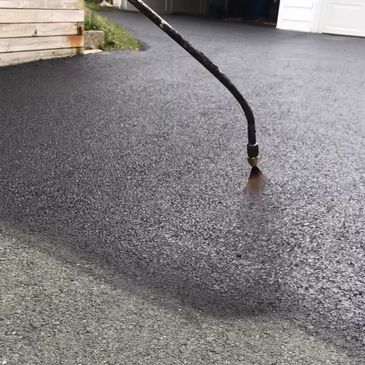Durable Outcomes: Asphalt Spot Repair With Precision Sealing
Cold Mix Asphalt Vs. Hot Mix Asphalt: Which Is Right for You?

Structure Differences
Cold mix and warm mix asphalts vary dramatically in their structure, with unique attributes that affect their performance and applications. Cold mix asphalt is created by emulsifying the asphalt binder with water and an emulsifying agent before mixing it with accumulation. This method permits for the asphalt to be convenient at reduced temperatures, making it excellent for momentary repairs and for usage in cooler weather. Warm mix asphalt, on the various other hand, is made at heats, generally between 300-350 ° F, which helps to accomplish far better compaction and a much more resilient end product. The hot mix asphalt manufacturing procedure entails heating up the aggregate and asphalt binder separately before incorporating them at the asphalt plant.
Furthermore, cool mix asphalt tends to be less thick and much more adaptable than warm mix asphalt. This flexibility makes it far better suited for areas with greater levels of activity, such as driveways or roadways with hefty web traffic. In contrast, hot mix asphalt is known for its high durability and resistance to rutting and breaking, making it a favored option for highways and high-traffic roads where durability is important.
Setup Process Differences
The process of mounting chilly mix and hot mix asphalt exhibits significant variations in their needs and treatments. Cold mix asphalt, being an extra adaptable product, can be applied directly from the bag or container onto the gap or harmed location. It calls for marginal preparation job, such as cleaning the location and compacting the chilly blend with hand devices. This makes it a practical choice for temporary and quick repairs. On the other hand, warm mix asphalt requires an extra sophisticated installation procedure. It includes heating the mixture to heats before laying it down on a correctly prepared base. The preparation consists of condensing the base, using a tack coat, and using heavy machinery like pavers and compactors for a long lasting and smooth coating. Because of the heating demands, hot mix asphalt setups are generally executed by professionals with customized tools, guaranteeing a more long-term and structurally sound result.
Durability and Long Life Factors
When taking into consideration asphalt choices, resilience and durability are essential elements to examine for lasting sidewalk performance. Hot mix asphalt (HMA) is known for its view website extraordinary toughness and longevity.
In terms of longevity, HMA generally exceeds CMA because of its premium strength and resistance residential or commercial properties. HMA sidewalks have a longer life span, calling for less constant repair services and maintenance, which can translate to cost savings over time. Furthermore, HMA pavements are extra conveniently customizable to meet details task needs, additionally boosting their longevity.
Price Factors To Consider
Thinking about the financial effects is an essential aspect when assessing the choice between warm mix asphalt (HMA) and chilly mix asphalt (CMA) for pavement jobs. While the preliminary price of warm mix asphalt is his response typically higher than that of cool mix asphalt, HMA commonly supplies an extra cost-efficient option in the long run due to its premium longevity and long life.
In enhancement to product costs, it's essential to take into consideration the expenditures connected with setup and upkeep when contrasting HMA and CMA. Ultimately, the choice between HMA and CMA ought to take into account not just the initial expense however additionally the lasting monetary effects to determine the most cost-effective alternative for the particular sidewalk task.
Environmental Effect Comparison
Contrast of the ecological influences in between hot mix asphalt (HMA) and cool mix asphalt (CMA) discloses distinctive distinctions in sustainability practices. HMA manufacturing calls for high temperature levels, leading to increased energy consumption and greenhouse gas discharges.
Furthermore, making use of CMA frequently includes recycling existing asphalt pavement, advertising source preservation and reducing the quantity of waste sent to landfills. This recycling element further boosts the sustainability of CMA compared to HMA. On the whole, when taking into consideration the environmental effect, CMA arises as an extra environmentally sustainable choice due to its reduced energy requirements, lowered discharges, and the possibility for recycling existing materials. By going with CMA over HMA, road building and construction projects can contribute positively to environmental preservation efforts.
Verdict
To conclude, the selection between cool mix asphalt (CMA) and hot mix asphalt (HMA) depends on numerous elements such as structure, installation process, longevity, long life, expense, and ecological impact. asphalt repair. While CMA offers a quick and economical remedy for minor repair services, HMA makes certain superior resilience and long life for heavy traffic areas. Take into consideration these aspects thoroughly to figure out which sort of asphalt is the appropriate option for your paving requires

Thinking about the economic ramifications is an essential element when evaluating the choice in between warm mix asphalt (HMA) and chilly mix asphalt (CMA) for sidewalk projects. While the initial price of hot mix asphalt is usually higher than that of chilly mix asphalt, HMA commonly offers a much more cost-effective solution in the long run due to its premium sturdiness and durability. asphalt patch official source repair.Comparison of the ecological effects between warm mix asphalt (HMA) and chilly mix asphalt (CMA) exposes distinct differences in sustainability practices.In conclusion, the selection between cold mix asphalt (CMA) and hot mix asphalt (HMA) depends on various elements such as structure, installation process, resilience, durability, expense, and environmental influence